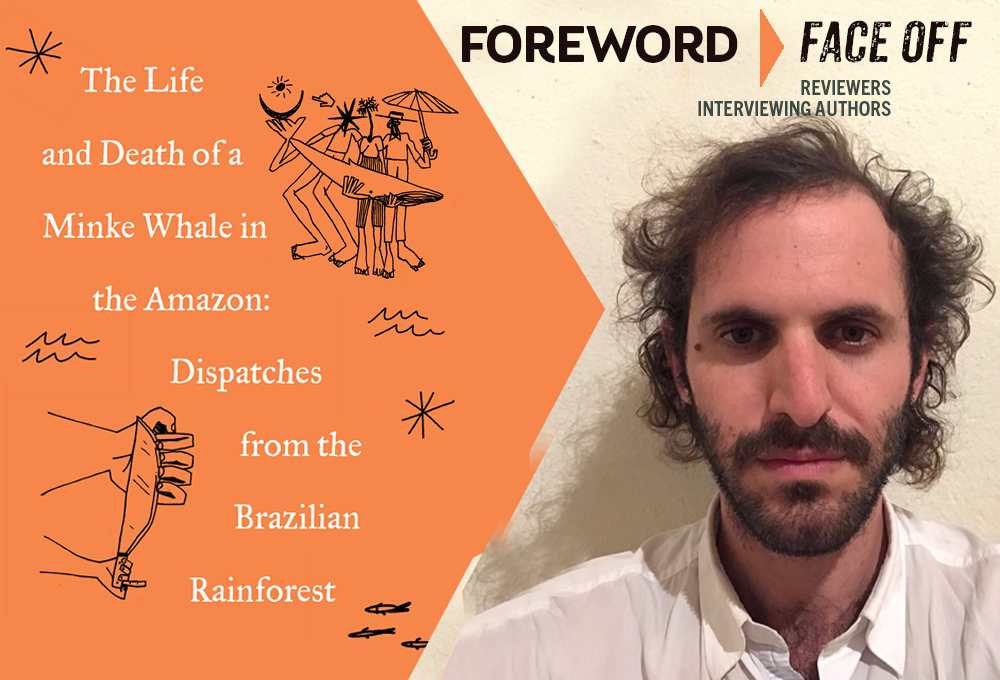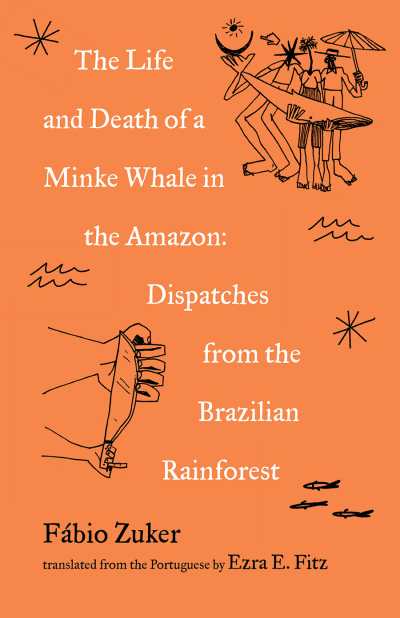Reviewer Rachel Jagareski Interviews Fábio Zuker, Author of The Life and Death of a Minke Whale in the Amazon: Dispatches from the Brazilian Rainforest

An enduring lesson of human history are the atrocities that predictably takes place when a technologically advanced people takes aim at the resources of a pre-industrialized Indigenous community. Often referred to as colonizing—let’s just call it what it is: thievery and genocide—in its barbarity, it may define humanity better than any other behavior.
And no, in this enlightened twenty-first century, we have not outgrown the habit, as children do thumbsucking.
This week’s sobering conversation takes us to Brazil, land of plenty and long a playground for visiting thieves and murderers. But as we learn from Fábio Zuker, there’s a similar pervasive form of crime committed against Indigenous people—this time perpetrated by professional types in business suits. In his interview below with Rachel Jagareski, Fábio describes his new book as his attempt to denounce the violations against Brazil’s Indigenous community that happens alongside “deforestation and other forms of destruction of the world’s biggest tropical forest.”

Rachel Jagareski offered The Life and Death of a Minke Whale in the Amazon a starred review in Foreword‘s May/June issue and their conversation deserves everyone’s attention.
Your book traverses so much of Brazil and is a vivid introduction to its diverse cultural and natural landscape. Was this book written with an international audience in mind?
The essays of the book were primarily published in different Brazilian media outlets, for the Brazilian public. But at the same time, these are dispatches about a region that many Brazilians have never been to and do not know much about. So I’ve tried to use narrative journalism techniques—and the way they intersect with my ethnographic writing as I was trained as an anthropologist—to give a full picture of how life looks in these situations of conflict and violence in the Amazon forest. This is a book that is denouncing the human rights violations that come along with the deforestation and other forms of destruction of the world’s biggest tropical forest. And to do so, I found that in-depth descriptions of these situations were the best path to create a human sense of the situation.
Coming back to the heart of the question, the book was not particularly produced for an international audience, rather it was produced with the intention of narrating these situations to people who don’t know the Amazonian region and are interested in understanding more about it, through human-led narratives.
Your author biography describes you as a nonfiction writer and journalist. I also see you as a passionate advocate for the land and Indigenous people of the Brazilian Amazon. Would you agree? How do you balance factual reportage and opinion in your writing?
Hmmm, perhaps I have a slightly different opinion, in the sense that these are very factual, accurate dispatches of the violence perpetrated against Amazonian Indigenous communities and other traditional groups in Brazil. This means that I think it is possible to combine a sense of denunciation in such a violent context, investigative reporting, narrative writing, and my admiration and true respect for these populations as a whole and for the indigenous individuals that I’ve met while reporting. What I mean is that, given the extent of the violence perpetrated against these populations, rigorous reporting of the situation becomes a denunciation and an act of advocacy for their lives.
The soybean is a recurrent villain in your linked essays, responsible for soil and water pollution, agribusiness smothering of small farmers, increased food insecurity, and driving rural poverty and emigration. How can this message more effectively reach the eco-conscious consumers of this monoculture export who might push for change?
Yes, if we consider the soybean in the way it is produced, but not the soybean as a crop. This means that it is more about the way it is planted (as a mono-crop, as a plantation involving different levels of violence), than about the plant itself. For example, rice, palm trees for palm oil, and açaí when planted as mono-crop plantations are also creating the same kind of pollution and violence as soy fields. So, for some real change, my personal opinion is that it makes less sense to focus on individual habits, and more to pressure government and financial institutions that allow and/or invest in food production systems so entangled with human rights violations and deforestation.
Another theme is the similarity of contemporary land use clashes between people with radically divergent worldviews compared with those of colonial history. Are you pessimistic that history will be repeated and the powerful will uproot the less powerful from their homelands? Or are you optimistic that public awareness of climate change or other shifts in thinking will transform our present domination of the environment to a more harmonious way of living with the land?
I’m on the optimistic side! I think if I wasn’t, I wouldn’t be doing this work. My personal opinion is that what we are witnessing now, in terms of environmental violence towards Indigenous populations and other groups that inhabit and defend forests, just can’t stand much longer. It will have to cease because what is at stake is pretty much life on earth. I believe that we are starting to understand that these forest formations, cultivated for thousands of years by Indigenous groups in the Amazon and elsewhere, are cutting-edge technologies, and essential infrastructures for life to be able to continue existing on this planet.
Your interviews with Indigenous people from all corners of the rainforest illuminate the struggles to maintain cultural traditions and control of the land. How important is storytelling’s role in promoting environmental justice?
This is precisely the point! Thank you for putting it this way! This book is all about narrative experimentation around the role storytelling can have in promoting environmental justice. There are great, amazing journalistic investigations into the percentage of deforestation caused by a certain company, or tracing multinational companies and bank institutions financing companies involved in human rights violations in tropical forests. But if we miss the human side, the fact that there are concrete individuals that embody these stories, we miss a lot of what is actually happening on the ground.
Your profile of the Tukano kumua (shaman) and the traditional practice of maintaining bodily health through constant mediation with the guardians of the natural world was intriguing. You note that the health of Indigenous communities has suffered greatly from the trauma of colonization and Western medicine’s dismissal of traditional healing methods. How can these two healthcare models be more effectively integrated to better serve patients?
I think this question connects to the first part of the previous question. Perhaps differently than Western cultural conceptions (and more specifically conservative Western cultural assumptions), the Indigenous world seems to be much more skilled in combining heterogeneous cultural aspects and avoiding a sense of purity. Indigenous worlds, in the plural, are worlds in which it seems to make much more sense to think of “this plus this,” than of “either this, either that.” In this sense, in the kumuã story, I’m trying to retell the struggle of these shamans to retain their healing practices and perform them alongside western medicine—although they are constantly discredited by western physicians. The experiments João Paulo Barreto and his family and other Rio Negro kumuãs are doing in the city of Manaus, that I describe in the story, are amazingly rich ways of combining these absolutely different healing methods and bodily conceptions.
Rachel Jagareski
